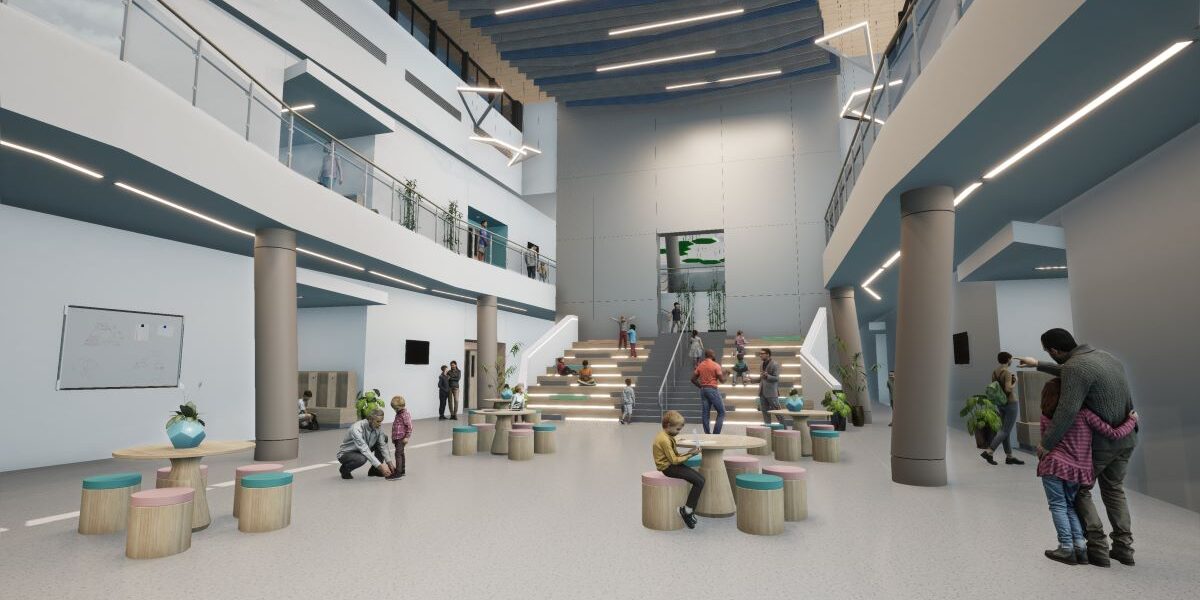One of the most profound influences on private school facility design has been the shift toward more holistic and flexible learning environments. In the early 2000s, most private school buildings adhered to classic designs characterized by single-purpose classrooms arranged along linear hallways.
Today, our school designs emphasize openness, adaptability, and student engagement. Schools are increasingly moving away from rigid classroom structures to create multifunctional spaces that support various learning styles, including collaborative, project-based, and individualized learning.
Increased Demand for Collaborative Spaces
Many Christian schools are now focusing on fostering a sense of community and collaboration throughout their facilities. Learning hubs, common areas, and interdisciplinary spaces are increasingly prioritized, encouraging interaction among students and faculty. This approach aligns with the broader trend toward experiential and social-emotional learning, which has gained traction over the last 20 years.
Collaborative spaces have become increasingly popular in school lobbies / common areas or clusters of classrooms. They can support group projects and hands-on activities that help students develop higher-level thinking skills, which can better prepare them for real-world situations and their careers. Collaborative spaces can also provide a physical representation of virtual interactions between students, educators, and different academic disciplines.
At Calvary Christian Academy in Fort Lauderdale, Florida, BGW is currently designing an 80,000+ square foot, 2-story K-3 building that will incorporate many of these themes of openness, adaptability, and student engagement, including large expansive lobby areas with integrated spaces for collaboration and play.
Flexibility and Adaptability
In recent years, driven by the rising costs of construction and maintenance, churches and Christian schools have increasingly collaborated to construct shared facilities designed for flexible, multi-purpose use. Gymnasiums, for example, are constructed to serve as both athletic spaces for schools and fellowship or event spaces for churches. Classrooms are often built with modular walls and advanced technological integration, allowing them to transition from instructional settings during the week to Bible study or youth group spaces on weekends.
BGW recently completed a 47,000-square-foot Family Ministry Center at NorthCreek Church & Academy in Walnut Creek, California, that comprises many of these multi-use components that are shared by the church and school. The 3-story facility features a regulation gymnasium with 2 side courts and bleachers, library, and a 300+ seat chapel for weddings, memorials, ministry and school events, inside/outside eating facilities connected to the kitchen and gym, meeting rooms, bride’s room, equipment storage space and restrooms with showers and lockers. The second floor features a fitness/wellness center, meeting rooms, multi-use spaces and restrooms. The building also includes a large basement that is used strictly for storage and will be accessed by elevator, allowing the buildings and grounds team to transport supplies to the first floor.
Specialized Classrooms & Labs
We have seen a resurgence in Career and Technical Education (CTE) & Family & Consumer Sciences (FCS) Programs among our Christian school clients. From the 1990s through the 2010s, most traditional CTE or “shop classes” disappeared from middle schools and high schools across the U.S. — one of the many issues that helped create today’s skilled labor shortage in metalworking and computer controlled machine shops. The global economy has grown increasingly competitive while students have continued to leave school underprepared for well-paying twenty-first century jobs.
At Southwest Christian High School in Chaska, Minnesota, BGW Architects has completed three phases of construction over the last decade. The second phase featured a whole new wing below the performing arts building dedicated to CTE. Called the “Pro-Tech” area, this wing features classrooms for robotics, engineering, computer assisted design (CAD) labs, maker’s labs where students can collaborate to create and invent new things utilizing 3D printers, software, electronics, craft, hardware supplies and all kinds of tools, as well as more traditional wood shop and metal shop spaces.
Family & Consumer Sciences (FCS) or “Home Economics” was popular in the mid-20th century, but in the 1970-80s, schools began reducing or eliminating them from curriculum, largely due to changing societal norms, budget constraints and the focus on standardized testing and college-preparatory courses. In recent years have seen a resurgence of interest in these essential life skills, driven by a desire for self-sufficiency, nutrition awareness, and personal well-being.
BGW is currently in the final design stages with Delmarva Christian School in Milton, Delaware, on a 73,000-square-foot facility for 6th-12th grade, a 13,000-square-foot Early Learning Center for PK2 – PK4, and the renovation of the existing high school facility to accommodate grades K-5. The design features an emphasis on FCS learning spaces, with integrated classroom/kitchen spaces that support both lecture and hands-on learning formats.
Technological Integration
The integration of technology has significantly influenced private school facility design and construction, especially in the last decade. Classrooms are now built to accommodate advanced technological tools, such as smart boards, interactive displays, high-speed Internet access, and flexible power solutions. Schools are implementing technology-enhanced learning spaces such as virtual reality labs and media centers designed to promote STEM education.
It has also become increasingly important to consider the digital infrastructure required to support blended and online learning. Enhanced Wi-Fi systems, soundproofed virtual learning rooms, and digital resource libraries have become critical components of new construction and renovation projects. The COVID-19 pandemic further accelerated this trend as private schools adapted their facilities to support remote learning capabilities and hybrid education models.
Performing Arts Adaptations
In recent years, we have seen Christian school clients across the U.S. increasingly prioritize the development of state-of-the-art performing arts facilities to attract students and enhance their educational offerings.
However, rising construction costs have significantly impacted how schools approach these projects, leading to noticeable shifts in design, planning, and funding. The cost of construction materials, labor, and regulatory compliance has escalated substantially over the last decade. Factors such as supply chain disruptions, inflation, and higher demand for skilled labor have contributed to these increasing costs.
As a result, private schools are finding it more challenging to fund large-scale performing arts centers that require specialized acoustics, staging, and technological infrastructure. In response to budgetary constraints, many private schools are opting for smaller, more flexible performance spaces rather than grand, single-purpose theaters. Modular designs that can accommodate a variety of performances, from music recitals to theatrical productions, have become popular.
One significant area of cost-saving adaptation we are experiencing with performing arts spaces is in acoustic systems. Traditional high-cost solutions, such as full-scale fly lofts and elaborate rigging systems, are increasingly being replaced by more economical options. For example, instead of constructing expensive fly lofts that allow for vertical movement of scenery and backdrops, some schools are opting for “low-slung” houses—lower-profile performance spaces with limited vertical space but optimized acoustics.
BGW recently completed a 13,000-square-foot Performing Arts Theater for Woodland Christian School in Woodland, California. The theater seats up to 530 people and features a 1,076 SF stage with a low-slung house, backstage prep area, dressing rooms, offices and an upper balcony / mezzanine level. It also features a flat, open floor area in front of the stage where portable seating can be utilized to make the theater more flexible for multiple uses.
Schools are also making use of modular acoustic panels and retractable curtains that can be adjusted to improve sound quality without requiring extensive structural modifications. Acoustic shells that can be repositioned based on performance needs are also gaining popularity as a cost-effective way to enhance sound projection and clarity.
The evolving landscape of K-12 private school facility design reflects a dynamic balance between ambition and practicality. As construction costs continue to rise, schools are adopting innovative solutions to create high-quality educational environments without exceeding their budgets.
Trends such as flexible, multi-purpose spaces, cost-efficient acoustic systems, and technological integration demonstrate a shift towards practicality and adaptability. Collaborative funding strategies and adaptive re-use/renovations over new construction indicate a strategic approach to resource management.
Ultimately, the emphasis on creating versatile, future-proof spaces reflects private schools’ commitment to providing exceptional learning experiences despite financial and logistical challenges.
Derek Johnson is chief marketing and business development officer for Building God’s Way/BGW Architects, whose mission is to build God’s Kingdom by translating the God-given vision of Christian organizations through innovative, stewardship-driven design, www.bgwservices.com.













